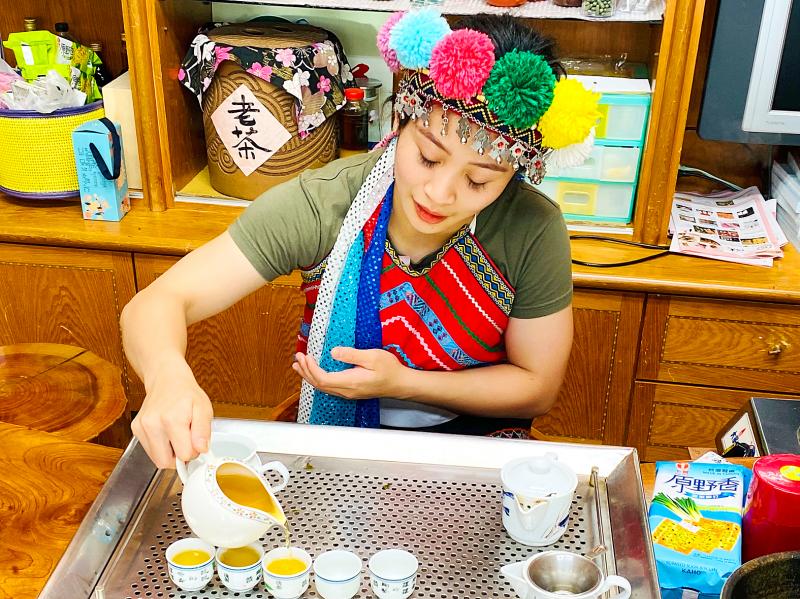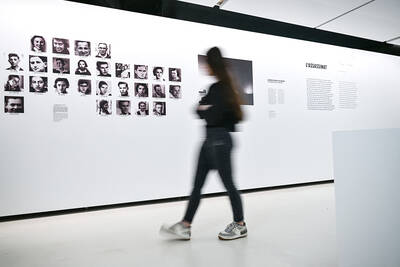Tsou Aborigine Fang Wan-ling, who represented Taiwan at the 2020 Tokyo Olympics and attained fourth place in the women’s 49kg weightlifting event, last week returned to her home village in Chiayi County to act as spokesperson for Alishan high mountain tea.
Although Fang’s family moved from Chiayi County to Tainan many years ago, after becoming an overnight sensation during the Olympics, she decided to return to her roots in Chiayi and use her celebrity stardust to promote her home region. Fang traveled deep into the Alishan mountain range to pick tea leaves at an alpine tea plantation. Although it was strenuous work, Fang had no complaints and wore her usual smile, beaming from ear to ear throughout.
Fang’s maternal uncle Wu Ching-shan, who is a Chiayi County councilor, says Fang moved to Tainan when she was a second-year student at Lalayua Elementary School because of her mother’s work. However, Fang keeps up ties with her home village, to which she has returned twice since the Olympics. During this trip, Fang was able to stay for a relatively long time and elected to pick tea at a high-altitude tea garden in the Tfuya area of Tapangu Village, after which she traveled to the New Fuyuan tea processing factory to learn about sun-withering and other aspects of tea production.

Photo: Tsai Tsung-hsun, Liberty Times 照片:自由時報蔡宗勳
Fang says she often helped her grandmother pick tea as a kindergarten student and, as a little child, she would often play hide-and-seek among the tea bushes. Fang adds that these childhood memories are still fresh in her mind and her experience of picking tea as an adult, bending over the tea bushes and dripping in sweat, felt somewhat different from before. Having appreciated how much labor goes into tea production, Fang hopes she can do her bit to help market her home village’s aromatic high mountain tea.
(Liberty Times, translated by Edward Jones)
東京奧運舉重比賽拿下女子四十九公斤級第四名、嘉義縣鄒族方莞靈,上週返鄉代言大阿里山高山茶。

Photo: Tsai Tsung-hsun, Liberty Times 照片:自由時報蔡宗勳
即使方莞靈已經舉家搬至台南市居住,因奧運瞬間成名後,她並不忘本,奧運結束後返嘉參加活動,並深入偏遠的高山茶園實地採茶,過程相當辛苦,但她不喊累,依舊笑容可掬。
方莞靈的舅舅、嘉義縣議員武清山指出,方莞靈讀到樂野國小二年級時,因媽媽工作的關係搬到台南市居住,但跟家鄉仍互動熱絡,這次回故鄉是奧運比賽返國後第二次,因時間比較充裕,安排到達邦村特富野的高海拔茶園體驗採茶,並到新福源製茶廠了解日光萎凋等過程。
方莞靈說,讀幼兒園的時候常跟著奶奶去茶園採茶,那時候因個子小,經常躲在茶叢中玩樂,這個童年記憶仍歷歷在目,這次彎著腰採茶又是不一樣的體驗,沒一會兒就汗如雨下,真的很辛苦,覺得甘甜的故鄉茶來之不易,有機會就會大力幫忙行銷。
(自由時報蔡宗勳)

Historians are rethinking the way the Holocaust is being presented in museums as the world marks the 80th anniversary of the liberation of the last Nazi concentration camps this month. Shocking images of the mass killings of Jews were “used massively at the end of World War II to show the violence of the Nazis,” historian Tal Bruttmann, a specialist on the Holocaust, told AFP. But in doing so “we kind of lost sight of the fact that is not normal to show” such graphic scenes of mass murder, of people being humiliated and dehumanized, he said. Up to this

When people listen to music today, they typically use streaming services like YouTube or Spotify. However, traditional formats like vinyl records have regained popularity in recent times. Vinyl records are circular discs that store music in grooves on their surfaces and are played on a turntable. As the turntable’s needle runs along these grooves, it picks up vibrations and translates them into sound. The history of vinyl records dates back to the late 1800s, but material and technological challenges delayed mass production until the 1950s. Despite early versions having short playtimes and poor sound quality, vinyl records introduced a new era

A: Brazilian jiu-jitsu, known as “BJJ,” has become more and more popular. Even Hollywood stars like Halle Berry and Tom Hardy are obsessed with it. B: Some Asian stars, such as Taiwanese actor Eddie Peng and South Korean actor Lee Joon-gi, have also practiced this martial art. A: BJJ is not just a martial art, but also a combat sport. B: I’ve always wanted to try it, but I’m worried about getting injured. A: Diana Wang, a US doctor of physical therapy, is holding a BJJ seminar at PMA Brazilian Jiu-jitsu in Taipei Friday night. Let’s go check out how we

Dos & Don’ts — 想想看,這句話英語該怎麼說? 1. 能做的事都做了。 ˇ All that could be done has been done. χ All that could be done have been done. 註︰all 指事情或抽象概念時當作單數。例如: All is well that ends well. (結果好就是好。) All is over with him. (他已經沒希望了。) That’s all for today. (今天到此為止。) all 指人時應當作複數。例如: All of us are interested in his proposal. All of us are doing our best. 2. 我們這麼做有益於我們的健康。 ˇ What we are doing is good for our health. χ What we are doing are good for our health. 註︰以關係代名詞 what 引導的作為主詞的子句,動詞用單數。如: What he said is true. 3. 大家都沿著步道跑。 ˇ Everybody runs along the trail. χ Everybody run along the trail. 註︰everyone 是指一大群人,但在文法上一般用單數。 4. 桌上有一本筆記本和兩支筆。 ˇ There were two